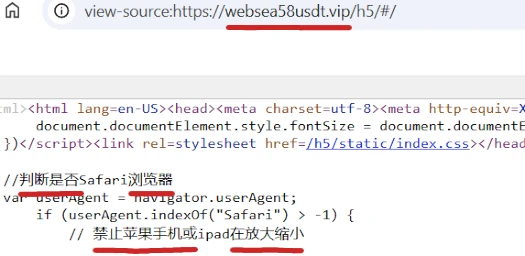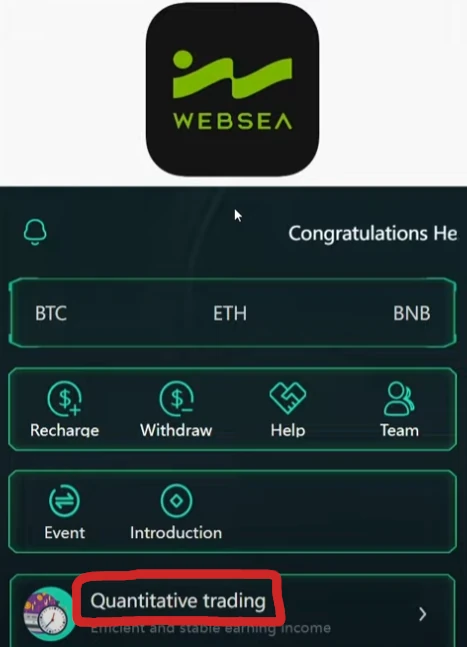Websea USDT Review: Stolen identity “click a button” Ponzi
Websea USDT fails to provide ownership or executive information on its website.
Websea USDT operates from two known website domains:
- websea58usdt.vip – privately registered on April 2nd, 2025
- web-sea567-usdt.com – privately registered on April 21st, 2025
If we look at the source-code of Websea USDT’s website, we find Chinese:

This suggests whoever is running Websea USDT has ties to China.
As always, if an MLM company is not openly upfront about who is running or owns it, think long and hard about joining and/or handing over any money.
Websea USDT’s Products
Websea USDT has no retailable products or services.
Affiliates are only able to market Websea USDT affiliate membership itself.
Websea USDT’s Compensation Plan
Websea USDT affiliates invest tether (USDT). This is done on the promise of advertised returns:
- VIP1 – invest 12 USDT and receive 1.5 USDT a day
- VIP2 – invest 82 USDT and receive 10.3 USDT a day
- VIP3 – invest 332 USDT and receive 42.56 USDT a day
- VIP4 – invest 823 USDT and receive 111 USDT a day
- VIP5 – invest 2532 USDT and receive 347 USDT a day
- VIP6 – invest 6532 USDT and receive 933 USDT a day
- VIP7 – invest 15,688 USDT and receive 2341 USDT a day
- VIP8 – invest 45,688 USDT and receive 7028 USDT a day
- VIP9 – invest 85,688 USDT and receive 13,820 USDT a day
- VIP10 – invest 166,888 USDT and receive 33,776 USDT a day
- VIP11 – invest 356,888 USDT and receive 79,308 USDT a day
Websea USDT pays referral commissions on invested USDT down three levels of recruitment (unilevel):

- level 1 (personally recruited affiliates) – 12%
- level 2 – 3%
- level 3 – 1%
Joining Websea USDT
Websea USDT affiliate membership is free.
Full participation in the attached income opportunity requires a minimum 12 USDT investment.
Websea USDT Conclusion
Websea USDT is yet another “click a button” app Ponzi scheme.
Websea USDT misappropriates the name and branding of Websea, a crypto trading platform.

Needless to say Websea USDT has nothing to do with Websea the trading platform.
Websea USDT’s Ponzi ruse is “quantitative trading”. The presented ruse is Websea USDT affiliates log in and click a button (the more invested the more the button needs to be clicked).
Clicking the button purportedly generates revenue via quantitative trading, which for some reason Websea USDT shares a percentage of with affiliate investors.
If that makes no sense it’s because it doesn’t. Randoms clicking a button in an app doesn’t trigger quantitative trading.
In reality clicking a button inside Websea USDT’s app does nothing. All Websea USDT does is recycle newly invested funds to pay earlier investors.
Examples of already collapsed “click a button” app Ponzis using the stolen identity ruse are Pantera Capital VIP, Lufthansa MVP and Toyota WRC. Recent quantitative trading ruse examples are Treasure, EOS Quantify and Q-Research.
Since 2021 BehindMLM has documented hundreds of “click a button” app Ponzis. Most of them last a few weeks to a few months before collapsing.
“Click a button” app Ponzis disappear by disabling both their websites and app. This tends to happen without notice, leaving the majority of investors with a loss (inevitable Ponzi math).
In the lead up to a collapse, “click a button” Ponzi investors also tend to find their accounts locked. This typically coincides with a withdrawal request.
As part of a collapse, “click a button” Ponzi scammers often initiate recovery scams. This sees the scammers demand investors pay a fee to access funds and/or re enable withdrawals.
If any payments are made withdrawals remain disabled or the scammers cease communication.
Organized crime interests from China operate scam factories behind “click a button” Ponzis from south-east Asian countries.
In September 2024, the US Department of Treasury sanctioned Cambodian politician Ly Yong Phat over ties to Chinese human trafficking scam factories.
Through various companies he owns, Phat is alleged to shelter Chinese scammers operating out of Cambodia.
Myanmar claims to have deported over 50,000 Chinese scam factory scammers since October 2023. With “click a button” app scams continuing to feature on BehindMLM though, it is clearly not enough.
In late January 2025, Chinese ministry representatives visited Thailand. The stated aim of the visit was to tackle organized Chinese crime gangs operating from Myanmar.
In early February 2025, Thailand announced it had cut power, internet access and petrol supplies to Chinese scam factories operating across its border with Myanmar.
As of February 20th, Thai and Chinese authorities claim ten thousand trafficked hostages had been freed from Myanmar compounds.
Also on February 20th, five Chinese crime bosses were nabbed in a wider raid of four hundred and fifty arrests in the Philippines.
On March 19th it was reported that, despite the recent raids and arrests, “up to 100,000 people” are still working in Chinese Myanmar scam factories.
As of April 2025 and in response to a crackdown across Asia, newly opened Chinese scam factories have been reported in Nigeria, Angola and Brazil.
Myawaddy is an area in Myanmar along the Thai border. Myawaddy is under the control of the Karen National Army (KNA).
The KNA, led by warlord Chit Thu (right) and sons Saw Htoo Eh Moo and Saw Chit Chit, protect and profit from organized Chinese criminals running “click a button” Ponzi scam factories.
 On May 5th the US imposed sanctions on Chit Thu (right).
On May 5th the US imposed sanctions on Chit Thu (right).
The Treasury said the warlord, Saw Chit Thu, is a central figure in a network of illicit and highly lucrative cyberscam operations targeting Americans.
The move puts financial sanctions on Saw Chit Thu, the Karen National Army that he heads, and his two sons, Saw Htoo Eh Moo and Saw Chit Chit, the department said in a statement, freezing any U.S. assets they may hold and generally barring Americans from doing business with them.
Britain and the European Union have already imposed sanctions on Saw Chit Thu.
Regardless of which country they operate from, ultimately the same group of Chinese scammers are believed to be behind the “click a button” app Ponzi plague.
Update 2nd July 2025 – Websea USDT has collapsed. As at the time of this update Websea USDT’s website is no longer accessible.

